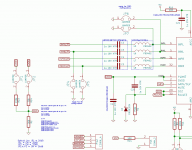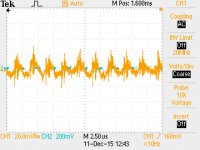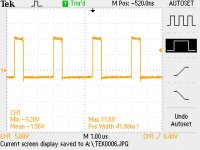Hello folks, I'm new here. I was inspired by chicks chromecast audio build and I was looking to do something similar. My gf has been taken by all the Sonos commercials, and I would like to build a few "single wire" bookshelf speakers. I dont see the point in doing stereo pairs for whole home audio (one in the bathroom, kitchen, etc). I figured a tpa3116 in PBTL mono mode makes sense.
So I was wondering if anyone has any experience with the board I ordered. I found this guide, but it doesn't seem to be applicable. There are 6 jumpers on the back you can reconfigure for PBTL mode... is it really as simple as that, and then bridging the outputs?
Here is the Amazon listing, and a very similar board which has a good photo of the back of the pcb.
I went with this board because I hope to have at least one built by Christmas 🙂
So I was wondering if anyone has any experience with the board I ordered. I found this guide, but it doesn't seem to be applicable. There are 6 jumpers on the back you can reconfigure for PBTL mode... is it really as simple as that, and then bridging the outputs?
Here is the Amazon listing, and a very similar board which has a good photo of the back of the pcb.
I went with this board because I hope to have at least one built by Christmas 🙂
Hey! it's ~10$ Delivered! Not much to lose.. is there?
That said.. it IS a 10$ Chi Fi amplifier...Keep your expectations firmly fixed on the Price paid... it Ain't No Firstwatt.
That said.. it IS a 10$ Chi Fi amplifier...Keep your expectations firmly fixed on the Price paid... it Ain't No Firstwatt.
What values does the R+C had?
Where did they, do you have a link for this?
I actually don't see a relationship between RC-filter and DC-offset due to imbalance.
Groupbuy boards are 10r/1u I recall.
TI support mentioned it a couple of times, searching that forum is terrible, but this is one question: we are making a few thousand boards based on amplifier chip TI 3116...
I don't think you looked, have you?
Hello folks, I'm new here. I was inspired by chicks chromecast audio build and I was looking to do something similar. My gf has been taken by all the Sonos commercials, and I would like to build a few "single wire" bookshelf speakers. I dont see the point in doing stereo pairs for whole home audio (one in the bathroom, kitchen, etc). I figured a tpa3116 in PBTL mono mode makes sense.
So I was wondering if anyone has any experience with the board I ordered. I found this guide, but it doesn't seem to be applicable. There are 6 jumpers on the back you can reconfigure for PBTL mode... is it really as simple as that, and then bridging the outputs?
Here is the Amazon listing, and a very similar board which has a good photo of the back of the pcb.
I went with this board because I hope to have at least one built by Christmas 🙂
The version you linked is an updated earlier ampboard that was sold as SMAKN on Amazon, now with added "bootstrap" snubbers. Yes PBTL is easy, yes lowering gain to 26dB is also easy.
Groupbuy boards are 10r/1u I recall.
TI support mentioned it a couple of times, searching that forum is terrible, but this is one question: we are making a few thousand boards based on amplifier chip TI 3116...
I don't think you looked, have you?
Sure i did, and i still don't see a relationship between dc-offset and the RC-filter.
The 10R+1u is from an older TI chip implementation - there's none for the 3132 in the datasteet but several ppl complained about noise without in the E2E forums for their 3116/3118. 10R+1u has kinda low/none influence on dc-offset.
700mV DC offset.. would mean, the AVCC is sagging and pulling some 35-70mA to have this drop on 10R.

I know you don't see because you imagine measuring as opposed to measuring.
People complain about noise with ampboards containing RCsplit too, all older generation ampboards have the split, wow how they complain about noise
People complain about noise with ampboards containing RCsplit too, all older generation ampboards have the split, wow how they complain about noise
Increase gainsetting/lower inputsignalswing (increase AVCC powerconsumption???) and DC reduces for same outputlevel but remains much higher than same ampboard without RCsplit. Does that point to sagging AVCC ?
The version you linked is an updated earlier ampboard that was sold as SMAKN on Amazon, now with added "bootstrap" snubbers. Yes PBTL is easy, yes lowering gain to 26dB is also easy.
Thank you. Hopefully "updated" means it's decent quality
 It was the best looking one I could find w/ free Prime shipping.
It was the best looking one I could find w/ free Prime shipping.I know you don't see because you imagine measuring as opposed to measuring.
People complain about noise with ampboards containing RCsplit too, all older generation ampboards have the split, wow how they complain about noise
Are you going to offend me? Do we have a personal problem here? 😕
Increase gainsetting/lower inputsignalswing (increase AVCC powerconsumption???) and DC reduces for same outputlevel but remains much higher than same ampboard without RCsplit. Does that point to sagging AVCC ?
What are you trying to say, I don't get the point, may you try again please?
Higher gain results in more quiescent current due to lower impedance.. ?
Hello folks, I'm new here. I was inspired by chicks chromecast audio build and I was looking to do something similar. My gf has been taken by all the Sonos commercials, and I would like to build a few "single wire" bookshelf speakers. I dont see the point in doing stereo pairs for whole home audio (one in the bathroom, kitchen, etc). I figured a tpa3116 in PBTL mono mode makes sense.
So I was wondering if anyone has any experience with the board I ordered. I found this guide, but it doesn't seem to be applicable. There are 6 jumpers on the back you can reconfigure for PBTL mode... is it really as simple as that, and then bridging the outputs?
Here is the Amazon listing, and a very similar board which has a good photo of the back of the pcb.
I went with this board because I hope to have at least one built by Christmas 🙂
That's the SMAKN board. I bought one from Amazon and it sounds decent. It's got a lot of options for soldering bridge points to change functionality like gain, PBTL, etc It is missing output snubber and of course, bootstrap snubber. Default gain is set high - good for phone source. $13 is Avery fair price.
That's the SMAKN board. I bought one from Amazon and it sounds decent. It's got a lot of options for soldering bridge points to change functionality like gain, PBTL, etc It is missing output snubber and of course, bootstrap snubber. Default gain is set high - good for phone source. $13 is Avery fair price.
Check again for bootstapsnubber, it is there, it is updated "smakn"
Are you going to offend me? Do we have a personal problem here? 😕
What are you trying to say, I don't get the point, may you try again please?
Higher gain results in more quiescent current due to lower impedance.. ?
I asked you couple of times earlier to test in reality the RCsplit, not in your head but on your bench. I asked because I felt your posts "promoted/supported" the thing. I also earlier pointed to this as being unlike your other posts, dismissing things "because not measured but heard"
In lowest gainsetting there is no voltage divider connected to gvdd output, avcc (gvdd input) doesn't need to provide any energy there. You make calculations linking sagging avcc to dc in outputsignal, I answered that seems strange to me, because when we do add work for avcc by selecting higher gain, dc in output drops.
I'm sorry but the gain resistors doesn't affect AVCC performance at all. The gain resistor network is pulling some 70uA at max - GVDD itself is at <200uA.

How did you took your measurements in detail, i will then repeat this on my board. Maybe we talk at cross purposes. 🙂
I wonder about a statement from your some month ago:
http://www.diyaudio.com/forums/class-d/237086-tpa3116d2-amp-753.html#post4375326
?
How did you took your measurements in detail, i will then repeat this on my board. Maybe we talk at cross purposes. 🙂
I wonder about a statement from your some month ago:
http://www.diyaudio.com/forums/class-d/237086-tpa3116d2-amp-753.html#post4375326
Connecting nothing to gvdd pin is within datasheet advisePO they call it, not PBY, but capacitor doesn't hurt or improve sound on blueboard here, ~25mm away from chippin, no need to leave it off, (just tried it several hours this afternoon till now, switching on off few dozen times too)
?
Attachments
Last edited:
Maybe you missed the reference, you can use groupbuy ampboards that have the RCsplit standard like I did. There is no need to mod anything, just measure the ampboard's speakeroutput with dipswitch in 20dB gainposition.
Datasheet doesn't tell you you must connect a capacitor and a voltage divider, it says you should not connect anything else than a capacitor and voltage divider. In German that might mean you must connect a capacitor and a voltage divider? The voltage divider part already tells you "must" isn't the translation.
Datasheet doesn't tell you you must connect a capacitor and a voltage divider, it says you should not connect anything else than a capacitor and voltage divider. In German that might mean you must connect a capacitor and a voltage divider? The voltage divider part already tells you "must" isn't the translation.
Maybe the sentence is a bit confusing, but "must" connect a capacitor is stated by "design" as a capacitor is needed for the ldo to work properly as it is part of the regulation loop. As we don't know the internals of the ldo-block it "might" be ok without if GVDD is derived from the internal AVDD voltage. If so, the GVDD voltage will conduct/couple back to AVDD at different loads as gatedrive current is a function of output "amplitude"/duty-cylce. -> GVDD cap with prevent this.
****, dunno actually. I measured it also on the pins where the supply voltage comes in on the pcb.
Plus i saw this also on the crossover part, it's connected with the same supply source
Plus i saw this also on the crossover part, it's connected with the same supply source
For further discussion i measured the DC-offset of my TPA3132D2 implementation.
Parameter:
TPA3132D2 board Rev 0.C
Li-Ion 12V 3s battery pack at 12.51V
DDS120/BM102 USB Scope
60Mhz probe
Analog inputs grounded
Gain at 26dB
400kHz switching frequency
No load connected
No bootstrap snubbers
no filter at all (straight out)
10R+1uF AVCC filter vs. 1uF only
DC-offset on left channel is about 20mV, right channel is about 3mV. Offset is not altered when R is bridged (zero ohm) but noise increases.
RC-Filter Left Channel:

RC-Filter Right Channel:

C-Only Left Channel:

C-Only Right Channel:

Conclusion:
On this board, DC-offset is not affected by AVCC-RC-Filter, but output noise is slighty improved compared to no filter.
🙂
Parameter:
TPA3132D2 board Rev 0.C
Li-Ion 12V 3s battery pack at 12.51V
DDS120/BM102 USB Scope
60Mhz probe
Analog inputs grounded
Gain at 26dB
400kHz switching frequency
No load connected
No bootstrap snubbers
no filter at all (straight out)
10R+1uF AVCC filter vs. 1uF only
DC-offset on left channel is about 20mV, right channel is about 3mV. Offset is not altered when R is bridged (zero ohm) but noise increases.
RC-Filter Left Channel:
RC-Filter Right Channel:
C-Only Left Channel:
C-Only Right Channel:
Conclusion:
On this board, DC-offset is not affected by AVCC-RC-Filter, but output noise is slighty improved compared to no filter.
🙂
Attachments
-
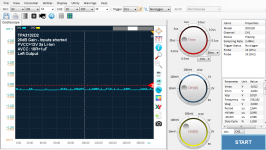 TPA3132D2_DC_Offset_with_AVCC-RC-Filter_Left_Channel.png98.9 KB · Views: 494
TPA3132D2_DC_Offset_with_AVCC-RC-Filter_Left_Channel.png98.9 KB · Views: 494 -
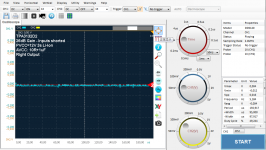 TPA3132D2_DC_Offset_with_AVCC-RC-Filter_Right_Channel.png.png104.9 KB · Views: 494
TPA3132D2_DC_Offset_with_AVCC-RC-Filter_Right_Channel.png.png104.9 KB · Views: 494 -
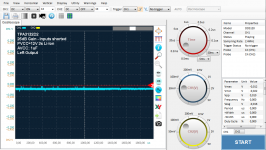 TPA3132D2_DC_Offset_with_AVCC-C-Only_Left_Channel.png99.2 KB · Views: 501
TPA3132D2_DC_Offset_with_AVCC-C-Only_Left_Channel.png99.2 KB · Views: 501 -
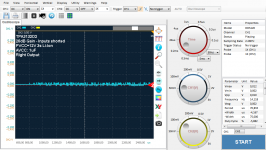 TPA3132D2_DC_Offset_with_AVCC-C-Only_Right_Channel.png99.5 KB · Views: 494
TPA3132D2_DC_Offset_with_AVCC-C-Only_Right_Channel.png99.5 KB · Views: 494
Last edited:
- Home
- Amplifiers
- Class D
- TPA3116D2 Amp
